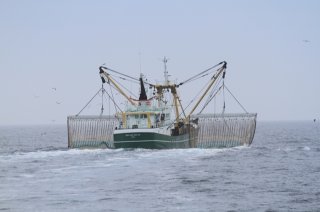
News
Findings on pulse fisheries presented in France
In France the pulse trawl fisheries is currently viewed with suspicion. The Dutch flatfish fleet however has good experiences with this innovation and the majority of the fishermen have switched from traditional beam trawl to pulse trawl, although the EU only allows this by exception.
Hans Polet (ILVO) and Adriaan Rijnsdorp (IMARES) therefore presented the BENTHIS findings on pulse trawl yesterday in a meeting in Duinkerke, France. The meeting was attended by representatives of the French and Dutch fishing industry, regional authorities such as Aires Marines Protégées and marine scientists from IFREMER and Universities.
The BENTHIS scientists showed how the pulse trawl compared to traditional trawl in term of catch efficiency, selectivity and impact on the seafloor. In addition, results of experiments carried out by IMARES and ILVO were presented. Polet: “In our field experiment the puls fisheries showed a 60% reduction of bycatch. This means that many benthic invertebrates such as hermit crabs, brittle stars and shellfish can escape with this technique”.
Rijnsdorp also provided an outlook to the broader goals of the project. “We want to assess the impacts of different fisheries in Europe. For that, we are now assessing the relationships between the foot print of a gear, the natural versus fishery induced disturbance and the impact of the gear on species and the ecosystem. In this way, we should be able to compare the impact of puls fisheries with that of any other bottom gear.”
The BENTHIS scientists showed how the pulse trawl compared to traditional trawl in term of catch efficiency, selectivity and impact on the seafloor. In addition, results of experiments carried out by IMARES and ILVO were presented. Polet: “In our field experiment the puls fisheries showed a 60% reduction of bycatch. This means that many benthic invertebrates such as hermit crabs, brittle stars and shellfish can escape with this technique”.
Rijnsdorp also provided an outlook to the broader goals of the project. “We want to assess the impacts of different fisheries in Europe. For that, we are now assessing the relationships between the foot print of a gear, the natural versus fishery induced disturbance and the impact of the gear on species and the ecosystem. In this way, we should be able to compare the impact of puls fisheries with that of any other bottom gear.”
The meeting was organised by Pieter Kuyt, representative of the Dutch fisheries. You may download the presentation here.
